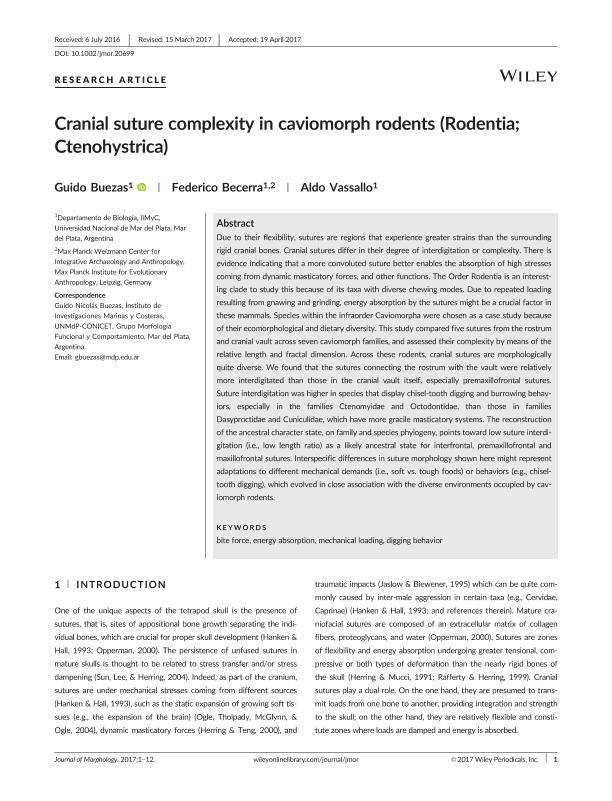Artículo
Cranial suture complexity in caviomorph rodents (Rodentia; Ctenohystrica)
Fecha de publicación:
08/2017
Editorial:
Wiley-liss, Div John Wiley & Sons Inc
Revista:
Journal of Morphology
ISSN:
0362-2525
e-ISSN:
1097-4687
Idioma:
Inglés
Tipo de recurso:
Artículo publicado
Clasificación temática:
Resumen
Due to their flexibility, sutures are regions that experience greater strains than the surrounding rigid cranial bones. Cranial sutures differ in their degree of interdigitation or complexity. There is evidence indicating that a more convoluted suture better enables the absorption of high stresses coming from dynamic masticatory forces, and other functions. The Order Rodentia is an interesting clade to study this because of its taxa with diverse chewing modes. Due to repeated loading resulting from gnawing and grinding, energy absorption by the sutures might be a crucial factor in these mammals. Species within the infraorder Caviomorpha were chosen as a case study because of their ecomorphological and dietary diversity. This study compared five sutures from the rostrum and cranial vault across seven caviomorph families, and assessed their complexity by means of the relative length and fractal dimension. Across these rodents, cranial sutures are morphologically quite diverse. We found that the sutures connecting the rostrum with the vault were relatively more interdigitated than those in the cranial vault itself, especially premaxillofrontal sutures. Suture interdigitation was higher in species that display chisel-tooth digging and burrowing behaviors, especially in the families Ctenomyidae and Octodontidae, than those in families Dasyproctidae and Cuniculidae, which have more gracile masticatory systems. The reconstruction of the ancestral character state, on family and species phylogeny, points toward low suture interdigitation (i.e., low length ratio) as a likely ancestral state for interfrontal, premaxillofrontal and maxillofrontal sutures. Interspecific differences in suture morphology shown here might represent adaptations to different mechanical demands (i.e., soft vs. tough foods) or behaviors (e.g., chisel-tooth digging), which evolved in close association with the diverse environments occupied by caviomorph rodents.
Palabras clave:
Bite Force
,
Digging Behavior
,
Energy Absorption
,
Mechanical Loading
Archivos asociados
Licencia
Identificadores
Colecciones
Articulos(IIMYC)
Articulos de INSTITUTO DE INVESTIGACIONES MARINAS Y COSTERAS
Articulos de INSTITUTO DE INVESTIGACIONES MARINAS Y COSTERAS
Citación
Buezas, Guido Nicolás; Becerra, Federico; Vassallo, Aldo Iván; Cranial suture complexity in caviomorph rodents (Rodentia; Ctenohystrica); Wiley-liss, Div John Wiley & Sons Inc; Journal of Morphology; 278; 8; 8-2017; 1125-1136
Compartir
Altmétricas




